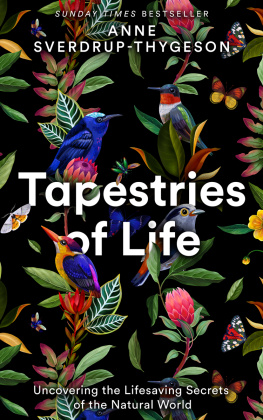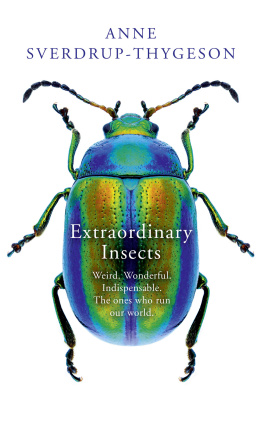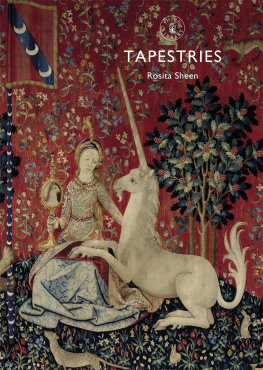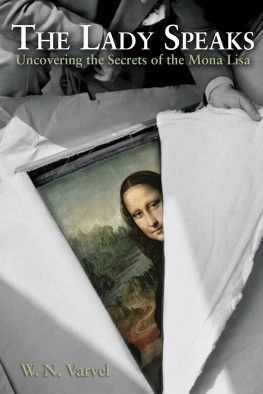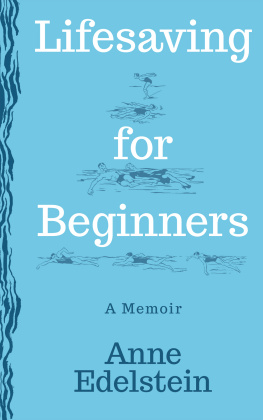Anne Sverdrup-Thygeson - Tapestries of life : uncovering the lifesaving secrets of the natural world
Here you can read online Anne Sverdrup-Thygeson - Tapestries of life : uncovering the lifesaving secrets of the natural world full text of the book (entire story) in english for free. Download pdf and epub, get meaning, cover and reviews about this ebook. year: 2021, genre: Children. Description of the work, (preface) as well as reviews are available. Best literature library LitArk.com created for fans of good reading and offers a wide selection of genres:
Romance novel
Science fiction
Adventure
Detective
Science
History
Home and family
Prose
Art
Politics
Computer
Non-fiction
Religion
Business
Children
Humor
Choose a favorite category and find really read worthwhile books. Enjoy immersion in the world of imagination, feel the emotions of the characters or learn something new for yourself, make an fascinating discovery.
- Book:Tapestries of life : uncovering the lifesaving secrets of the natural world
- Author:
- Genre:
- Year:2021
- Rating:3 / 5
- Favourites:Add to favourites
- Your mark:
- 60
- 1
- 2
- 3
- 4
- 5
Tapestries of life : uncovering the lifesaving secrets of the natural world: summary, description and annotation
We offer to read an annotation, description, summary or preface (depends on what the author of the book "Tapestries of life : uncovering the lifesaving secrets of the natural world" wrote himself). If you haven't found the necessary information about the book — write in the comments, we will try to find it.
Anne Sverdrup-Thygeson: author's other books
Who wrote Tapestries of life : uncovering the lifesaving secrets of the natural world? Find out the surname, the name of the author of the book and a list of all author's works by series.
Tapestries of life : uncovering the lifesaving secrets of the natural world — read online for free the complete book (whole text) full work
Below is the text of the book, divided by pages. System saving the place of the last page read, allows you to conveniently read the book "Tapestries of life : uncovering the lifesaving secrets of the natural world" online for free, without having to search again every time where you left off. Put a bookmark, and you can go to the page where you finished reading at any time.
Font size:
Interval:
Bookmark:

Mudlark
An imprint of HarperCollinsPublishers
1 London Bridge Street
London SE1 9GF
www.harpercollins.co.uk
HarperCollinsPublishers
1st Floor, Watermarque Building, Ringsend Road
Dublin 4, Ireland
First published by Mudlark 2021
FIRST EDITION
Text Anne Sverdrup-Thygeson 2021
Translation Lucy Moffatt 2021
Illustrations Tomislav Tomi/Arena 2021
Cover layout design by Andrew Davis HarperCollinsPublishers 2021
Cover illustrations Shutterstock.com
A catalogue record of this book is available from the British Library
Anne Sverdrup-Thygeson asserts the moral right to be identified as the author of this work
All rights reserved under International and Pan-American Copyright Conventions. By payment of the required fees, you have been granted the nonexclusive, non-transferable right to access and read the text of this e-book on screen. No part of this text may be reproduced, transmitted, downloaded, decompiled, reverse engineered, or stored in or introduced into any information storage retrieval system, in any form or by any means, whether electronic or mechanical, now known or hereinafter invented, without the express written permission of HarperCollins e-books.
Find out about HarperCollins and the environment at
www.harpercollins.co.uk/green
Source ISBN: 9780008402730
Ebook Edition June 2021 ISBN: 9780008402761
Version: 2021-05-19
This ebook contains the following accessibility features which, if supported by your device, can be accessed via your ereader/accessibility settings:
- Change of font size and line height
- Change of background and font colours
- Change of font
- Change justification
- Text to speech
- Page numbers taken from the following print edition: ISBN 9780008402730
What I discovered was that everything which meant most to me as a naturalist was being threatened, and that nothing I could do would be more important.
RACHEL CARSON (190764), SCIENTIST AND THE MOTHER OF THE MODERN ENVIRONMENTAL MOVEMENT
I was the kind of kid who asked questions about everything. All the time. A chatterbox, eternally inquisitive and doubtless obnoxiously precocious at times. In primary school I had an autograph book. A hideous bright green with a big floral pattern on its soft cover, typical 1970s. In among the usual Roses are red, violets are blue and By hook or by crook, Ill be first in this book, inscribed in felt tip in my school pals neat joined-up writing, there was a double page entirely taken up by my brother. Hed written a poem for me, which started like this: Youve asked me time and time again, most likely googolplex and continued with a list of all the stuff I used to ask him about.
Googolplex isnt just an enormously big number 10 to the power of one followed by a hundred zeros (more than all the atoms in the universe); there is also something magical about the word itself, a bit like a spell. And I collected lovely words as a child: words that had a marvellous way of rolling and tumbling around in my mouth when I said them, like onomatopoeic, or the ones that hop-scotched from my uvula and across my tongue to land on its tip, like trigonometric point. My grandfather introduced me to more fascinating words, including the Latin names of plants like Tussilago farfara for coltsfoot. In summer time, high up on the Norwegian mountain plateau of Golsfjellet, hed show me quartz crystals, the place where purple saxifrage grew and how the golden plover sang. My grandfather lived to 102 and I still think of him every summer when I hear the golden plovers mournful cry, high up above the treeline. Back home in Oslo, he would sit in the wing chair in the corner of our living room reading The Cormorants of Utrst aloud from the two-volume fairy-tale collection. As I grew, so too did the scope of our conversations; he told me about Loki and the mistletoe, Jason and the Golden Fleece, transatlantic crossings to America by ship in the 1930s, the two world wars
My family had a cabin on a little island out on a lake in the forest where I spent holidays and countless weekends. It was a two-room log cabin with no electricity or running water but it was right up close to nature. Summers were filled with the tarry aroma of sun-warmed cabin walls, posters of mushroom species in the outhouse, perch caught in fish traps, bristling with tiny bones, wild strawberries from the cabin roof, wood-chopping and the tedium of enforced lingonberry-picking trips that never seemed to end. I read my way through adventure books for boys, their covers slightly mildewed from the damp of the boathouse where they were stored.
Since the cabin was a long way from the nearest community indeed, a long way from the nearest neighbour the skies were wonderfully starry in winter. As a teenager, I once made a bed of spruce branches out on the ice for me and my friend Nina, then dug out some wartime-era sleeping bags from the shed and organised an outdoor sleepover so we could look at the stars. Forty years later, my clearest memory of that night is not the Milky Way but the strange, crackling dry object my bare feet encountered at the bottom of my sleeping bag an object that proved, on further investigation by the light of my torch, to be a mouse nest full of dead and mummified pups
Sometimes people ask why Im so keen on writing about insects and other seemingly insignificant creatures with PR problems; whether Im one of those people who collected bugs as a child. Im not. But I was lucky enough to grow up in a family that spent a lot of time outdoors as a matter of course and was interested in the stories and language that describe the relationship between us and nature, past and present. And a family that allowed me to be curious and tried to answer my never-ending questions about how everything fitted together.
Curiosity and a capacity for wonderment are also important to me as a scientist. Since I am a professor of conservation biology, the science that studies threats to biological diversity and ways of dealing with them, Ive wondered a lot about how to get people to appreciate the natural world around us so that well all want to take care of it too. This book is my attempt at an answer: I want to show you all the things that the wonderful natural world does so that you can see whats at stake. And I want to point out the paradox in our creative relationship with nature: we have made use of it, but our ability to exploit the benefits of nature also risks undermining the very foundations of our own existence.
A Hornless Rhino
Some years back, I attended a science conference in Dublin. In between lectures about pollination and malaria mosquitoes, I took time out to visit the citys natural history museum, the National Museum of Ireland. I love museums and this one was especially interesting: cases containing insects collected by Darwin himself; the skeleton of a giant red deer, its antlers broader than I am tall a melancholy monument to an extinct species; an exhibition containing several hundred astonishingly delicate glass models of marine invertebrates, created in the 1800s by German glass artists, the Blaschkas.
The glass figures were made as teaching aids, because it was difficult to display these sea creatures in any other way sea anemones and soft corals tended to end up as shapeless, colourless lumps in the bottom of a jar of formalin. Several thousand of these elegant artworks were sold to museums, universities and schools throughout the world, and those that have survived are quite a sight.
Font size:
Interval:
Bookmark:
Similar books «Tapestries of life : uncovering the lifesaving secrets of the natural world»
Look at similar books to Tapestries of life : uncovering the lifesaving secrets of the natural world. We have selected literature similar in name and meaning in the hope of providing readers with more options to find new, interesting, not yet read works.
Discussion, reviews of the book Tapestries of life : uncovering the lifesaving secrets of the natural world and just readers' own opinions. Leave your comments, write what you think about the work, its meaning or the main characters. Specify what exactly you liked and what you didn't like, and why you think so.

